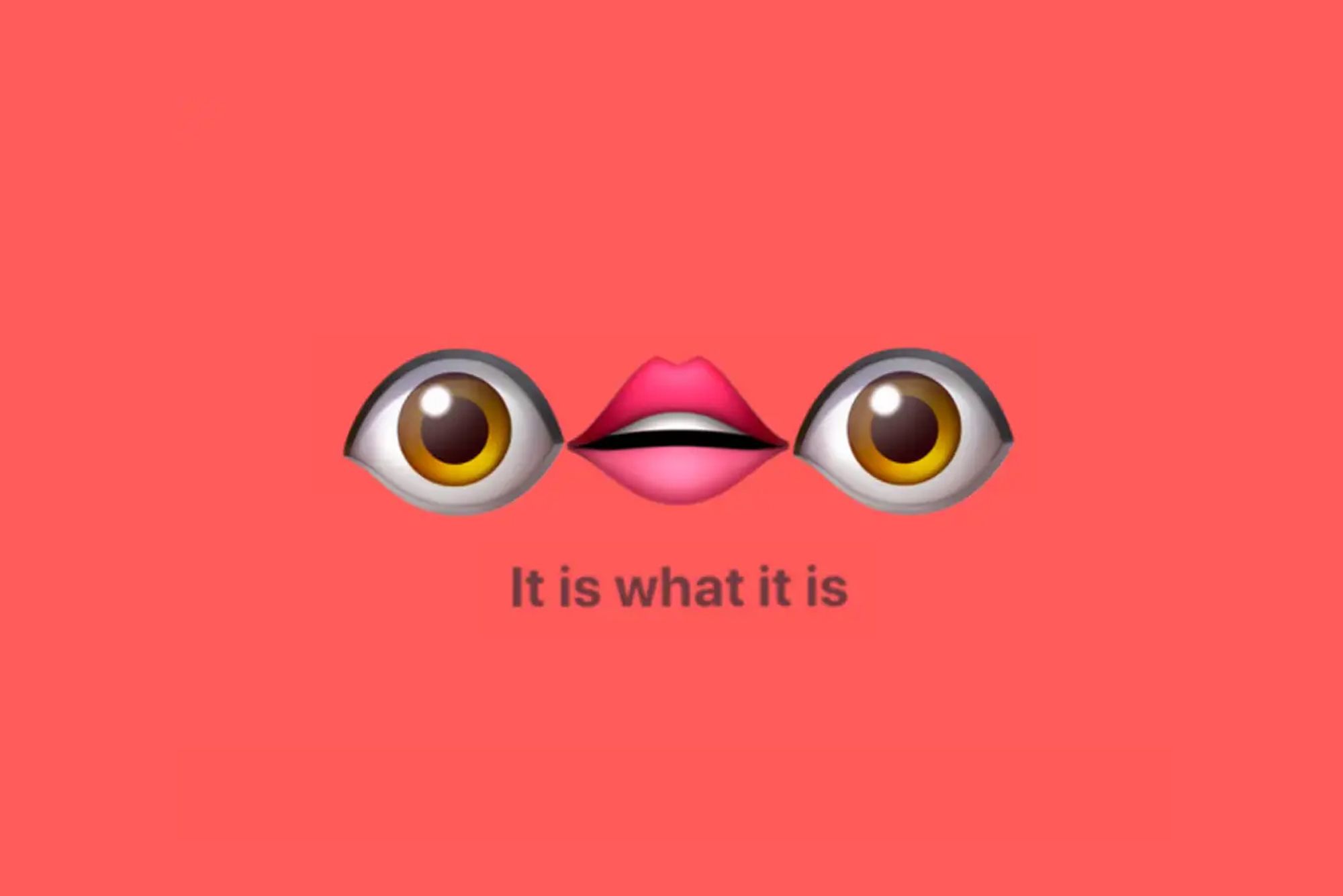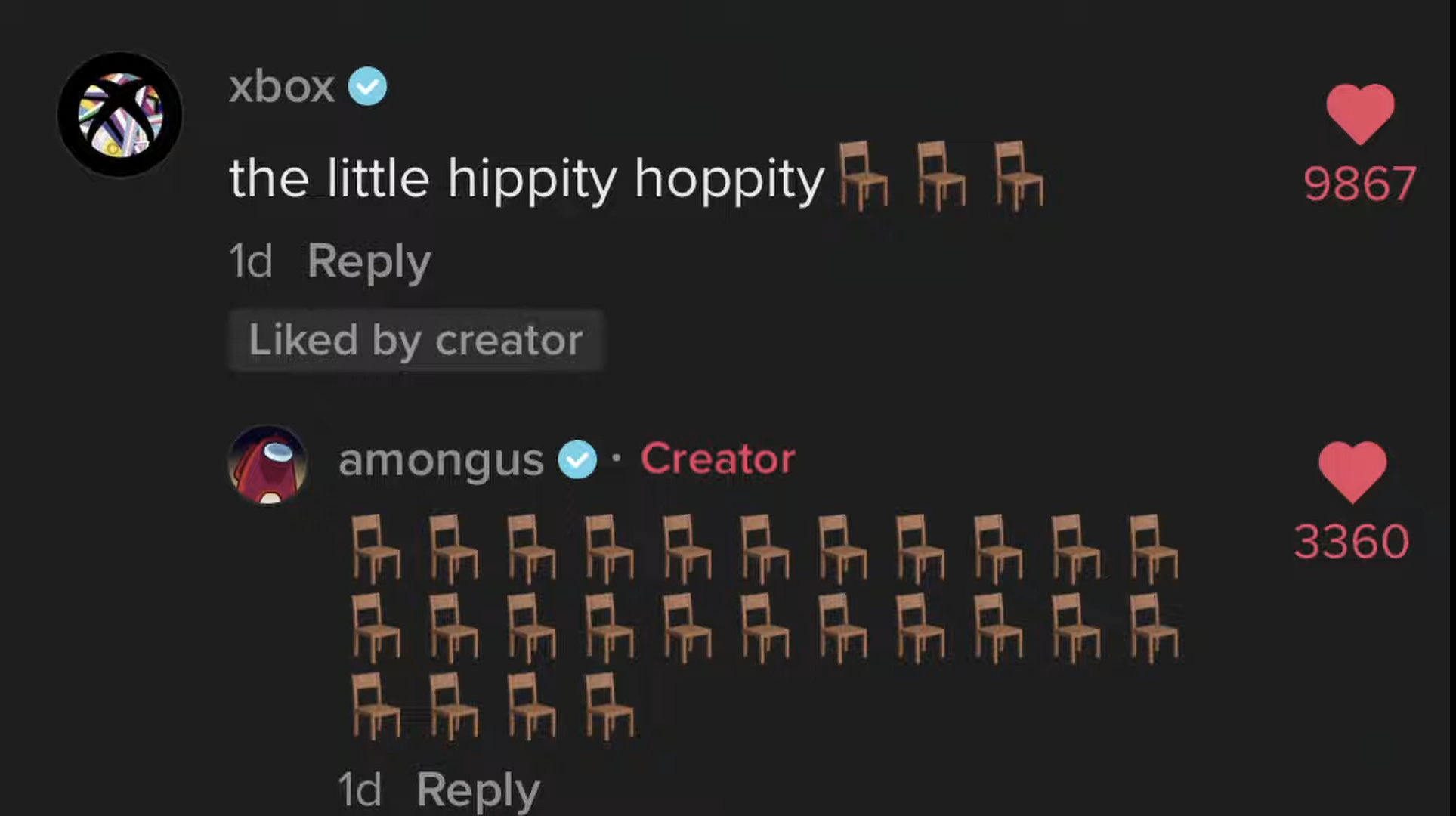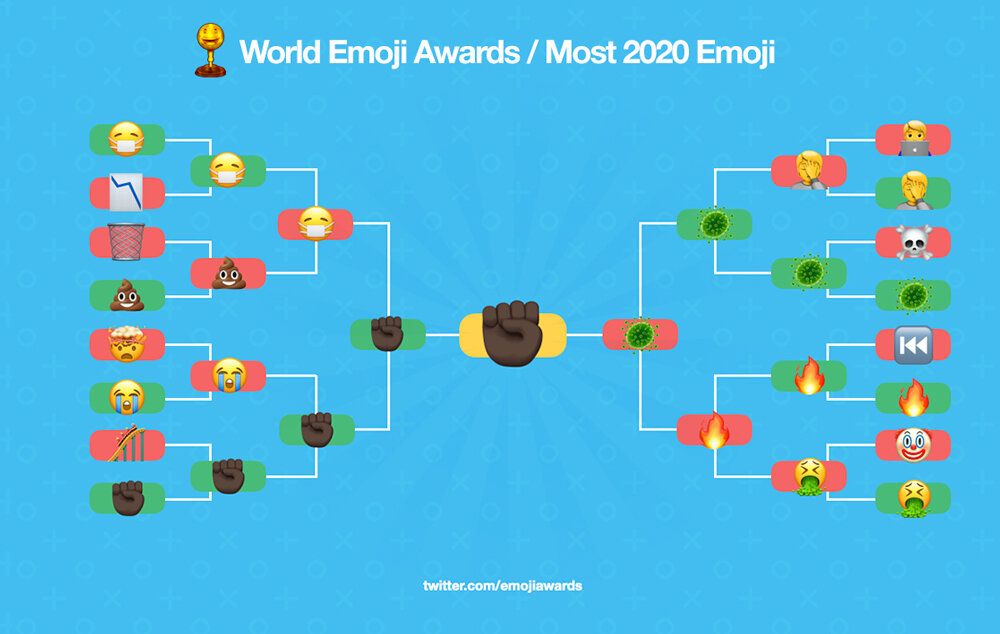10 Years of Viral Emoji Moments
For the last 10 years, we here at Emojipedia have been providing the world with up-to-date and well-researched emoji information. In doing so, we've documented a large number of emoji-based viral moments - here are our 10 most memorable.

For the last 10 years, we here at Emojipedia have been providing the world with up-to-date and well-researched emoji information.
In doing so, we've spent many a long time researching emoji use across various social networking platforms and documenting an impressive number of emoji-based viral moments- from 🅱️ B Button on Reddit (which didn't quite make our list) to the 🅿️ P Button on Tiktok.
Below we've outlined ten of the most impactful and memorable viral emoji moments across social platforms over the last ten years.
In cataloging these, we've focused on viral memes, trends, and oddities that have featured very specific emoji characters from our emoji keyboards (apologies to emoji pasta memes of the mid-2010s, the "chad" Emojidex TikToks, and the recently viral blue face emoji image).
Signing off with the 🫡 Saluting Face
Starting off with a very recent viral emoji trend from late last year, the 🫡 Saluting Face went viral across Twitter following the news that the microblogging platform would be dramatically reducing its own staff numbers as part of a company-wide restructuring following its acquisition by Elon Musk.
Use of the 🫡 Saluting Face as a means of saying farewell to work colleagues first began within Twitter's internal Slack, before following on to to Twitter itself, with the 🫡 Saluting Face being placed alongside the 💙 Blue Heart emoji.
Today would have been my 9 year work anniversary at Twitter, and instead it’s my first day as a former Tweep. 🐦🫡
— Ariel Adkins (@artfullyawear) November 4, 2022
While my time at Twitter has just come to an end, I am endlessly grateful for the experience of a lifetime that this little bird afforded me. 🧵 pic.twitter.com/uYnne3ihRL
After 11 beautiful, life-changing years I have officially resigned from Twitter. 🫡 💙
— david mclaughlin (@dmcg) November 4, 2022
The surge in use of the 🫡 Saluting Face across Twitter led to it becoming one of our most popular Emojipedia site pages during November, and at the time of writing it remains within our top 30 most popular pages.
In many respect, the viral use of the 🫡 Saluting Face as a sign-off from departing Twitter staff acted as an impossible-to-ignore declaration that a 🫡 Saluting Face emoji was finally on our keyboards.
Added in 2021's Emoji 14.0, the 🫡 Saluting Face had been a long-standing request, appearing in Emojipedia's own 2017 and 2018 top emoji request lists.
Since its viral moment, this emoji has continued to experience considerable global use and was declared the best emoji of 2022 by Rolling Stone Magazine.
🫡 emoji of the year i think. genuinely don’t remember how i used to communicate before it
— 🎐 (@cix_eria) November 19, 2022
No emoji was better suited for the ups and downs 2022 than the saluting face. https://t.co/FKRcf0bs6F
— Rolling Stone (@RollingStone) December 6, 2022
The 🫡 emoji really is goated
— Cosmonaut X-Men RPG Truther (@CosmonautMarcus) July 10, 2023
Pushing positivity with the 🅿️ P Button
In January 2022, American rappers Gunna, Future, & Young Thug released a track entitled “pushing P”.
While the phrase has disputed origins and meanings ("keep it real", "player", "paper", "positivity" etc), two things about “pushing P” are undeniable:
- the popularity of the track (it debuted at #7 on the Billboard Hot 100)
- its impact on the largely ignored 🅿️ P Button emoji
Following the release of the track, the 🅿️ P Button surged in use across both Twitter and Tiktok, with a huge number of the 300k+ Tiktok videos using the “pushin P” sound by the end of January 2022 also featuring the emoji across captions and comments.
Following the release of the track, the 🅿️ P Button surged in use across both Twitter and Tiktok, with a huge number of the 300k+ Tiktok videos using the “pushin P” sound by the end of January 2022 also featuring the emoji across captions and comments.
@baby_simba47 Who pushing 🅿️ 👀 #freestle #rhymes #imrpov #rap #pushingp ♬ original sound - Simba Jones
@iamryanprice Are you PUSHIN 🅿️?! #streetinterview #fyp #pushinp ♬ pushin P (feat. Young Thug) - Gunna & Future
Such was the virality of the 🅿️ P Button emoji that major brands and celebrities also joined the emoji-based bandwagon.
We’re always pushing 🅿️ancakes.
— IHOP (@IHOP) January 19, 2022
We had an internal meeting, and without getting into details, we're pushin 🅿️ all year.
— Nike.com (@nikestore) January 20, 2022
Today the 🅿️ P Button has returned to relative obscurity, but for a time it was on top of the world.
Requesting reshares with the ♻️ Recycling Symbol
Here's a Twitter-specific viral trend for another largely ignored emoji, this time from late 2016 into early 2018.
Through analyzing Twitter data collected by the Internet Archive, we here at Emojipedia were able to establish that from early 2017 the ♻️ Recycling Symbol began to surge in popularity.
January 2017, it was within the top 10 most-used emojis on the platform, and by September 2017 it was the #2 emoji on the platform.
This meant that it was second only to 😂 Face with Tears of Joy, but overtook the 😭 Loudly Crying Face emoji, which would eventually become the only emoji to overtake the 😂 Face with Tears of Joy as the #1 emoji on the platform, if only for a short while.
♻️ Recycling Symbol would remain the #2 emoji on the platform until June 2018, at which time its use completely crashed. So, what happened?
This odd emoji trend was investigated by Emojitracker.com founder Matthew Rothenberg at the time, and through analyzing the tweets featuring the ♻️ Recycling Symbol he discovered there was a uniformity to them: the emoji was being placed at the end of tweets containing quotes from the Quran, the central religious text of Islam.
Roth deduced that the tweets were being created automatically by applications designed to aid in automated posting on behalf of the user and that the use of the ♻️ Recycling Symbol was an attempt at getting other Twitter users to share these Quran verses with their own followers, either via retweets or by signing up to the service.
It can only be assumed that in June 2018 these services were shut down by Twitter, leading to a completely cratering in the use of ♻️ Recycling Symbol on the platform.
Laughing with the 🪑 Chair
From 2017 Twitter to 2021 Tiktok, when it was decided that the 🪑 Chair would be used as a new symbol to convey laughter across the platform.
This stemmed from a viral video by creator Anthony Mai (@blank.antho) in September 2021, in which he declared to his then-over-one-million followers that if you've watched the video, you're now part of an "inside joke" where the 🪑 Chair should be used instead of the 😂 Face with Tears of Joy to convey laughter in emoji form.
@blank.antho cardboard obama cutout asian dude
♬ Tokyo Drift - Xavier Wulf
This quickly caught on across the platform, with the comment sections of a whole host of viral videos being flooded with 🪑 Chair emojis, with creator KSI also getting involved (though it has been hypothesized that KSI was involved from the early stages).
As intended, this confused millions of Tiktok users yet to see Mai's original video and led some news outlets to speculate as to whether it had a NSFW meaning.
just went on tiktok for the first time in a few weeks, why are the comment sections filled with chair emojis pic.twitter.com/a3qOb031Uz
— austina (@tinacantdrive) September 14, 2021
@blank.antho we will achieve total chair domination 🪑
♬ Mysterious - Andreas Scherren
As tends to happen with these major viral trends, major brand accounts also got involved in the comments.

Ultimately, however, the 🪑 Chair's virality was short-lived, with the emoji's use on the platform winding back within several weeks as the likes of 😭 Loudly Crying Face and 💀 Skull returned to being the top symbols for laughter on the platform.
That doesn't mean that Mai or other Tiktok creators won't try and repurpose another neglected emoji for a further viral trend in the future, however - perhaps 🚡 Aerial Tramway could get another unexpected boost at some point down the line.
Clapping 👏 To 👏 Add 👏 Emphasis 👏
The use of multiple 👏 Clapping Hands emoji in 👏 between 👏 each 👏 word 👏 in 👏 a 👏 sentence dates back to the early 2010s, when emojis were first beginning to explode in popularity within text messages and social media posts.
The emergence of emojis on our digital devices just so happened to coincide with the emergence of what has become known as the "emphasis clap" - the practice of clapping as a way to emphasize talking points.
Sources agree that this practice was initially popularised among African American women way in advance of emojis becoming widespread, but it was picked up by mainstream platforms such as Disney and Comedy Central at the same time as the practice was being "emojified" across the likes of Twitter and Tumblr.
The rise of the emoji-based emphasis clap was also covered in a series of think pieces by the likes of Slate and VICE in 2016 and 2017 respectively.
While this particular use style of the 👏 Clapping Hands emoji has lessened in popularity over the years, the 👏 Clapping Hands emoji itself has remained incredibly popular.
In fact, as of 2023, it's the third most popular gesture emoji, behind only the 🙏 Folded Hands and 👍 Thumbs Up (interestingly, both of these are also two highly debated emojis).
You can view the historic of the top gesture emojis on Twitter over the last 10 years view the bar chart race below.
This beat-based emphasis format has also been utilized with various other emojis across the likes of Tiktok. For example, ✍️Lesson✍️Pen✍️ emoji format from Tiktok which we document on Emojipedia in January 2021.

It is what it is 👁👄👁
I mean, what more needs to be said? 👁👄👁
Back in the summer of 2020, Silicon Valley investors become highly intrigued by a seemingly secretive new impending tech platform, prompting itself across Twitter with the combination of two 👁️ Eye emojis on either side of a single 👄 Mouth.
This wasn't the first time this unnerving series of emojis were strung together on the platform. As per Know Your Meme, the earliest known example of the 👁👄👁 is from a tweet all the way back in 2015, featuring Backstreet Boys lyrics.
Am I original?
— milly ❤️🔥 (@mily2502) September 11, 2015
Am I the only one?
Am ah SEX-U-AAAAAALLL
👁👄👁
Further isolated instances of 👁👄👁 followed over subsequent years.
people in other countries: that church was nearly burnt down in 1315 by a queen who found her husband cheating
— jaboukie (@jaboukie) November 2, 2018
americans: wow 👁👄👁 that mcdonalds has been there for 30 years
👁👄👁 pic.twitter.com/l6DgzLOhxt
— AMADA 😳Has a friend weeeeee (@AnasApprentice3) May 15, 2020
However, in June 2020 this off-putting emoji combo would become infamous.
Following a huge surge in interest in the 👁👄👁 emoji combo, the Twitter account @itiseyemoutheye began tweeting, and buzz began to surround it within the tech/investment sphere. What was this exactly? It seemed to be an absurdist promotional campaign for a new app launch, at least based on select tweets.
👁👄👁
— it is what it is (@itiseyemoutheye) June 26, 2020
06/26 7PM PST
— it is what it is (@itiseyemoutheye) June 26, 2020
Perhaps the most talked about launch of 2020?
— Product Hunt 😸 (@ProductHunt) June 26, 2020
It is what it is 👁 👄👁https://t.co/7n7oGPlLku pic.twitter.com/pTyw75TkwL
Additionally, the emoji domain 👁👄👁.fm was being shared across social platforms with a cryptic message of "It is what it is" and a request to "give us your info". All the hallmarks of a viral app launch, and as such it received mainstream media coverage.
Tech twitter rn pic.twitter.com/jGo28BH1ja
— YourStack (@yourstacks) June 26, 2020
Later, the site requested that visitors donate to three different US-based charities - namely the Loveland Foundation, The Innocence Project, and The Okra Project, seemingly with the promise of early access to the new platform if receipts were provided to prove that donations were made.
So, in the end, what was it all about? The creators of 👁👄👁.fm put it best themselves within their statement, which we've extracted excerpts from below:
A group of us changed our Twitter names to include 👁👄👁" because we thought it was a funny trend from TikTok.
What started out as a meme in our small group chat grew bigger than we ever imagined. So we thought about how to make use of the hype cycle we’d stumbled upon. But honestly, we didn’t have to think too hard: in this moment, there’s pretty much no greater issue to amplify than the systemic racism and anti-Blackness much of the world is only beginning to wake up to. We’re excited that we could use our newfound platform to drive action towards a few causes that are doing important work towards racial justice: Loveland Foundation Therapy Fund,The Okra Project,The Innocence Project, and others.
We’ve done pretty well for a non-existent product. 👁👄👁.fm was the top product of the day on Product Hunt (Theranos who?). The website accumulated 20,000 email signups and thousands of tweets sharing the link. We were covered in The Independent and Forbes. We got shoutouts from Josh Constine and Brianne Kimmel. Some folks on Reddit puzzled over who we were. Andrew Chen of Andreessen Horowitz, Shannon Purser of Stranger Things, and Elon Musk may have subtweeted us? The @itiseyemoutheye Twitter and accounts of our teammates were inundated with invite requests. Most importantly, we raised over $65,000 in donations from people who signed up for our email list. Two anonymous donors have agreed to match the first $60,000 and $75,000, bringing the total to $200,000.
In conclusion, it is what it is: a meme that leveraged the relentless hype of exclusive apps and redirected it towards a critical social need. Thank you, and remember that unlike 👁👄👁, #BlackLivesMatter and other social movements aren't trends or hype cycles. Let’s keep giving back as best as we can.
It was what it was 👁👄👁
Flagging problems with the 🚩 Triangular Flag
The 🚩 Triangular Flag emoji was amongst the earliest emojis in existence, dating back to late 1990s / early 2000s Japanese emoji sets created by Docomo and au by KDDI.
Rarely used in the decade following its introduction to the Unicode Standard in 2010, when it was it was most frequently associated with golf: a flag-focused version of the ⛳ Flag in Hole emoji, which was also part of some of the earliest Japanese emoji sets by Softbank, Docomo, and au by KDDI.
However, in October 2021 this emoji absolutely exploded in popularity across Twitter.
The cause of this? A series of viral posts where the 🚩 Triangular Flag's firming uniform color across different emoji vendors was used to channel the idiom of a "red flag" - a statement, behavior, or situation that should be considered a warning sign or a problem by those perceiving or experiencing it.
This term is frequently used to describe a "deal-breaker" behavior of attribute in a romantic partner and as such many of the viral tweets propelling the 🚩 Triangular Flag's new-found popularity reflected this.
“im sorry i hurt u so many times but NOW i wanna make things right” 🚩🚩🚩🚩🚩🚩🚩🚩🚩🚩🚩🚩🚩🚩🚩🚩🚩🚩🚩🚩🚩🚩#redflags
— deltathegreat (@adoringdelta) October 12, 2021
“I like pineapple on my pizza.”
— Shaykh Azhar Nasser (@ShaykhAzhar) October 13, 2021
🚩🚩🚩🚩🚩🚩🚩🚩🚩🚩🚩🚩🚩🚩🚩🚩🚩🚩
“shrek is not that good” 🚩🚩🚩🚩🚩🚩🚩🚩🚩🚩🚩🚩🚩🚩🚩🚩🚩🚩🚩🚩🚩🚩🚩🚩🚩🚩🚩🚩🚩🚩🚩🚩🚩🚩
— ♡ bri ♡ (@blazinwithbri) October 12, 2021
Receiving mainstream press attention from the likes of Insider and USA Today, many brands also joined in, including Twitter itself.
“I’m not on Twitter” 🚩🚩🚩🚩🚩🚩🚩🚩🚩🚩🚩🚩🚩🚩🚩🚩🚩🚩🚩🚩🚩🚩🚩🚩🚩🚩🚩🚩🚩🚩🚩🚩🚩🚩🚩🚩🚩🚩🚩🚩🚩🚩🚩🚩🚩🚩🚩🚩
— Twitter (@Twitter) October 12, 2021
"I'm not a Crocs person"🚩🚩🚩🚩🚩🚩🚩🚩🚩🚩🚩🚩🚩🚩🚩🚩🚩🚩🚩🚩🚩🚩🚩🚩🚩🚩🚩🚩🚩🚩
— Crocs (@Crocs) October 13, 2021
"No we don't have Dr Pepper" 🚩🚩🚩🚩🚩🚩🚩🚩🚩🚩🚩🚩
— Dr Pepper (@drpepper) October 13, 2021
“I don’t keep up with pop music” 🚩🚩🚩🚩🚩🚩🚩
— MTV (@MTV) October 13, 2021
Shining ✨ b R I G h T ✨
Historically speaking, the ✨ Sparkles emoji is one of the most popular emojis across the globe.

Originating from a visual convention in Japanese anime and manga to a sense of beauty, novelty, impressiveness, or, in the case of a character, internal joy or happiness (you can read our deep dive into the ✨ Sparkles emoji here).
However, in 2021 it was propelled into being the world's most popular symbol emoji - ahead of even the ❤️ Red Heart emoji - when it began to be incorporated more and more into a ✨ emphasis-based ✨ meme format that had been bubbling across different social platforms over the previous year or so.
By becoming the go-to emoji to bookend certain words or phrases ✨like this✨ to emphasize them within a sentence, the ✨ Sparkles emoji became a more modern incarnation of how italicization has historically been used in text.
This isn’t Bella, this is ✨Belinda Marie✨ pic.twitter.com/Z8JYmaN9Qw
— Bella Poarch (@bellapoarch) September 26, 2021

As we noted back in October 2021, TikTok's search results for a single ✨ Sparkles emoji showed how prominent this use case for this emoji had become on the platform.

While ✨ Sparkles-based emphasis can of course be used earnestly, it reached peak virality through its ability to convey a mocking, sarcastic, or negative tone of voice, especially when combined with CHaOTIC cApiTALiZATIon (also known as "SpOnGEbOb teXt") or indeed a d d i n g s p a c e s between the letters of certain words.

Indeed, the association between ✨ Sparkles and the SpOnGEbOb text has also likely led the emoji to be frequently used to indicate irony, sarcasm, or humor when bookending text even without the alternating capitalization.
@loewhaley + maybe a % merit increase that is less than the inflation rate #corporate #millennial #wfh ♬ original sound - Karen Chen
At the time of writing, the ✨ Sparkles remains an incredibly popular emoji, though as of early 2023 it has dropped from being the third most popular emoji in the world to the seventh, falling back behind 🤣 Rolling on the Floor Laughing, ❤️ Red Heart, 🙏 Folded Hands, and 😍 Smiling Face with Heart-Eyes.
Simpin' is easy with 🥺👉👈
Another string of three emojis is our penultimate viral emoji moment of the last 10 years, though the vital element here is the 🥺 Pleading Face emoji which was added to our emoji keyboards in 2018's Emoji 11.0 recommendations.
In fact, the 🥺 Pleading Face emoji is probably the most successful emoji of the last five years: a mere two years following its inclusion in our emoji keyboards, this emoji had skyrocketed to being the #3 emoji in the world between March 2020 and September 2021.
This was largely down to it being combined with the 👉 Backhand Index Pointing Right and 👈 Backhand Index Pointing Left - which, when combined, created an emoji version of a gesture that had begun to gain peak popularity amongst Gen Z in early 2020.
For example, here's friend of Emojipedia Lil Nas X shared a text-based meme circulating on Twitter from early 2020, which combines the 🥺 Pleading Face with the 👉 Backhand Index Pointing Right and 👈 Backhand Index Pointing Left emojis (as well as the 👟 Running Shoe and 🧦 Socks).
ma... i missed the... school bus again
— pussy (@LilNasX) February 26, 2020
🥺
👉🏾👈🏾
👟🧦
Additionally, Tiktoks such as one shown below began to speak across Tiktok - featuring the two fingers touching gesture alongside the 🥺 Pleading Face emoji and the term "simp".
@chrissycorsaro 👉🏼👈🏼🥺#fyp ♬ Black Mayo Jus Know bryansanon - Bryansanon
Swiftly the puppy-dog-eyed 🥺 Pleading Face emoji became synonymous with the concept of "simping": to show excessive sympathy and attention toward another person with whom you desired an affectionate or a sexual relationship, most frequently when that other person does not reciprocate those same feelings.
Like with the ✨ Sparkles emoji discussed above, 🥺 Pleading Face remains popular but has experienced a considerable decline in usage in recent years. In fact, despite at one time being the #3 emoji in the world, it is no loner amongst the world's top 10 emojis in 2023.
#BlackLivesMatter ✊🏼✊🏾✊🏿
We close out our list with an emoji viral trend with an incredibly important political issue at its center.
As reported back in June 2020, following the death of George Floyd and subsequent Black Lives Matter protests against racism and police brutality, Emojipedia experienced a signification increase in lookups of the ✊🏿 Raised Fist with Dark Skin Tone emoji.
Trending: ✊🏿 Raised Fist with Dark Skin Tone https://t.co/RYrQjh8jlz #BlackLivesMatter pic.twitter.com/tOEVGYtftF
— Emojipedia (@Emojipedia) June 1, 2020
Use of ✊🏾 Raised Fist: Medium-Dark Skin Tone and ✊🏿 Raised Fist: Dark Skin Tone began to rapidly increase around the 29th of May, the date on which a third degree murder charge was initially filed against former Minneapolis police officer Derek Chauvin.
Both then peaked in use on the 2nd of June, the day after two separate autopsies ruled that George Floyd’s death was a homicide.

Additionally, tweets that include at least one instance of the ✊🏾 or ✊🏿 emojis also include one or more of the following emojis:
- ✊🏽 Raised Fist: Medium Skin Tone
- ✊🏼 Raised Fist: Medium-Light Skin Tone
- ✊🏻 Raised Fist: Light Skin Tone
- 🖤 Black Heart
- ❤️ Red Heart
- 💯 Hundred Points
- 🔥 Fire
- 🙏🏾 Folded Hands: Medium-Dark Skin Tone
- ‼️ Double Exclamation Mark
- 😭 Loudly Crying Face
In fact, the combination of the three ✊ Raised Fist emojis with skin tone modifiers such as ✊🏼✊🏾✊🏿 has since become a popular emoji combination for conveying interracial solidarity
One month later, during our understandably more reserved World Emoji Day 2020 event, the ✊🏿 Raised Fist: Dark Skin Tone was voted as the Most 2020 Emoji as part of the World Emoji Awards, beating out both the 🦠 Microbe and 😷 Face with Medical Mask during the then-ongoing COVID-19 pandemic.

In fact, before we wrap this rundown of the our most memorable viral emoji moments of the last 10 years, we must given an honorable mention to both the 🦠 Microbe the 😷 Face with Medical Mask emojis.
Their viral moment may have burned out long before the end of the pandemic, but for a brief spell in March 2020 they were the only emoji anyone wanted to talk about.
